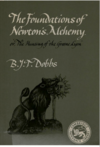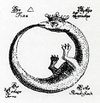Difference between revisions of "Affinity of reaction"
| Line 1: | Line 1: | ||
{{MitoPedia | {{MitoPedia | ||
|abbr=''A'' [J·mol<sup>-1</sup>] | |abbr=''A'' [J·mol<sup>-1</sup>] | ||
|description=The concept of '''affinity''' and hence chemical force is deeply rooted in the notion of '''attraction''' (and repulsion) of alchemy, which | |description=The concept of '''affinity''' and hence chemical force is deeply rooted in the notion of '''attraction''' (and repulsion) of alchemy, which was the foundation of chemistry originally, but diverted away from laboratory experiments towards occult secret societies [1]. Newton's extensive experimental alchemical work and his substantial written track record on alchemy (which he did not publish) is seen today as a key inspiration for his development of the concept of the gravitational force [2-4]. This marks a transition of the meaning of affinity, from the descriptive 'adjacent' (proximity) to the causative 'attractive' (force) [5]. Correspondingly, Lavoisier (1790) equates affinity and force [6]: “''... the degree of force or affinity with which the acid adheres to the base''” [5]. By discussing the influence of electricity and gravity on chemical affinity, Liebig (1844) considers affinity as a force [7]. This leads to Guldberg and Waage's [[mass action ratio]] ('Studies concerning affinity', 1864; see [5]), the free energy and chemical affinity of Helmholtz (1882 [8]), and chemical thermodynamics of irreversible processes [9], where flux-force relations are center stage [10]. | ||
According to the IUPAC definition, the '''affinity of reaction''', ''A'' [J·mol<sup>-1</sup>], equals the negative molar Gibbs energy of reaction [11], which is the negative Gibbs [[force]] of reaction (derivative of [[Gibbs energy]] per [[advancement]] of reaction [12]): | |||
-''A'' = Δ<sub>r</sub>''F'' = ∂''G''/∂<sub>r</sub>''ξ'' | -''A'' = Δ<sub>r</sub>''F'' = ∂''G''/∂<sub>r</sub>''ξ'' | ||
The historical understanding of affinity is summarized in the conclusion, that today affinity of reaction should be considered as an isomorphic motive '''[[force]]''' and be generalized as such | The historical understanding of affinity is summarized in the conclusion, that today affinity of reaction should be considered as an isomorphic motive '''[[force]]''' and be generalized as such. This will help to (''1'') avoid confusing reversals of sign conventions (repulsion = negative attraction; pull = negative push), (''2'') unify symbols across classical and nonequilibrium thermodynamics [12,13], and thus (''3'') facilitate interdisciplinary communication by freeing ourselves from the alchemical, arcane scientific nomenclature. | ||
|info=[[Cohen 2008 IUPAC Green Book]] | |info=[[Cohen 2008 IUPAC Green Book]] | ||
}} | }} | ||
Communicated by [[Gnaiger E]] 2018-12-27 (last update: 2019-01- | Communicated by [[Gnaiger E]] 2018-12-27 (last update: 2019-01-04) | ||
[[File:Dobbs 1975 Cambridge Univ Press.png|right|100px|link=Dobbs 1975 Cambridge Univ Press]] | [[File:Dobbs 1975 Cambridge Univ Press.png|right|100px|link=Dobbs 1975 Cambridge Univ Press]] | ||
== Attraction and repulsion == | == Attraction and repulsion == | ||
::::* Isaak Newton: ''And as in Algebra, where affirmative Quantities vanish and cease, there negative ones begin; so in Mechanicks, where Attraction ceases, there a repulsive Virtue ought to succeed.'' [ | ::::* Isaak Newton: ''And as in Algebra, where affirmative Quantities vanish and cease, there negative ones begin; so in Mechanicks, where Attraction ceases, there a repulsive Virtue ought to succeed.'' [2] | ||
[[File:Yin yang.png|left|60px|Transformation and convergence of opposites]] | [[File:Yin yang.png|left|60px|Transformation and convergence of opposites]] | ||
::::* Isaak Newton: ''That which is Above is like that which is Below and that which is Below is like that which is Above, to accomplish the miracles of only one thing.'' (transcription from Hermes Trismegistus [ | ::::* Isaak Newton: ''That which is Above is like that which is Below and that which is Below is like that which is Above, to accomplish the miracles of only one thing.'' (transcription from Hermes Trismegistus [4]) | ||
[[File:Volatile 1.jpg|left|80px|link=Dobbs 1975 Cambridge Univ Press]] | [[File:Volatile 1.jpg|left|80px|link=Dobbs 1975 Cambridge Univ Press]] | ||
::::* ''.. identifying the great mysterious symbols of alchemy as psychic images.'' [ | ::::* ''.. identifying the great mysterious symbols of alchemy as psychic images.'' [2] - the [[Oroboros symbol]] | ||
::::* '''''Given the unlimited validity of Clausius' law, it would then be the value of the free energy, not that of the total energy resulting from heat production, which determines in which sense the chemical affinity can be active.''''' ('''Helmholtz H. v. Die Thermodynamik chemischer Vorgänge''', SB, pg. 23, pg. 22-29, in Wissenschaftliche Abhandlungen von Hermann von Helmholtz. 3 vols. Leipzig: J.A. Barth, 1882-95.) [ | ::::* '''''Given the unlimited validity of Clausius' law, it would then be the value of the free energy, not that of the total energy resulting from heat production, which determines in which sense the chemical affinity can be active.''''' ('''Helmholtz H. v. Die Thermodynamik chemischer Vorgänge''', SB, pg. 23, pg. 22-29, in Wissenschaftliche Abhandlungen von Hermann von Helmholtz. 3 vols. Leipzig: J.A. Barth, 1882-95.) [10] | ||
[[File:EleazarA-1760 1L.jpg|right|100px|link=Jung 1944 Walter-Verlag |Eleazar 1760]] | |||
== References == | == References == | ||
:::# Jung CG (1944) Psychologie und Alchemie. Walter-Verlag Olten, 2. Auflage 1976:620 pp. - [[Jung 1944 Walter-Verlag |»Bioblast link«]] | |||
:::# Dobbs BJT (1975) The foundations of Newton's alchemy or "The hunting of the Greene Lyon". Reissued as a paperback 1983. Cambridge Univ Press Cambridge:300 pp. - [[Dobbs 1975 Cambridge Univ Press |»Bioblast link«]] | :::# Dobbs BJT (1975) The foundations of Newton's alchemy or "The hunting of the Greene Lyon". Reissued as a paperback 1983. Cambridge Univ Press Cambridge:300 pp. - [[Dobbs 1975 Cambridge Univ Press |»Bioblast link«]] | ||
:::# White M (1997) Isaak Newton. The last sorcerer. Fourth Estate, London 402 pp. - [[White 1997 Fourth Estate |»Bioblast link«]] | :::# White M (1997) Isaak Newton. The last sorcerer. Fourth Estate, London 402 pp. - [[White 1997 Fourth Estate |»Bioblast link«]] | ||
Revision as of 02:18, 4 January 2019
Description
The concept of affinity and hence chemical force is deeply rooted in the notion of attraction (and repulsion) of alchemy, which was the foundation of chemistry originally, but diverted away from laboratory experiments towards occult secret societies [1]. Newton's extensive experimental alchemical work and his substantial written track record on alchemy (which he did not publish) is seen today as a key inspiration for his development of the concept of the gravitational force [2-4]. This marks a transition of the meaning of affinity, from the descriptive 'adjacent' (proximity) to the causative 'attractive' (force) [5]. Correspondingly, Lavoisier (1790) equates affinity and force [6]: “... the degree of force or affinity with which the acid adheres to the base” [5]. By discussing the influence of electricity and gravity on chemical affinity, Liebig (1844) considers affinity as a force [7]. This leads to Guldberg and Waage's mass action ratio ('Studies concerning affinity', 1864; see [5]), the free energy and chemical affinity of Helmholtz (1882 [8]), and chemical thermodynamics of irreversible processes [9], where flux-force relations are center stage [10].
According to the IUPAC definition, the affinity of reaction, A [J·mol-1], equals the negative molar Gibbs energy of reaction [11], which is the negative Gibbs force of reaction (derivative of Gibbs energy per advancement of reaction [12]):
-A = ΔrF = ∂G/∂rξ
The historical understanding of affinity is summarized in the conclusion, that today affinity of reaction should be considered as an isomorphic motive force and be generalized as such. This will help to (1) avoid confusing reversals of sign conventions (repulsion = negative attraction; pull = negative push), (2) unify symbols across classical and nonequilibrium thermodynamics [12,13], and thus (3) facilitate interdisciplinary communication by freeing ourselves from the alchemical, arcane scientific nomenclature.
Abbreviation: A [J·mol-1]
Reference: Cohen 2008 IUPAC Green Book
Communicated by Gnaiger E 2018-12-27 (last update: 2019-01-04)
Attraction and repulsion
- Isaak Newton: And as in Algebra, where affirmative Quantities vanish and cease, there negative ones begin; so in Mechanicks, where Attraction ceases, there a repulsive Virtue ought to succeed. [2]
- Isaak Newton: That which is Above is like that which is Below and that which is Below is like that which is Above, to accomplish the miracles of only one thing. (transcription from Hermes Trismegistus [4])
- .. identifying the great mysterious symbols of alchemy as psychic images. [2] - the Oroboros symbol
- Given the unlimited validity of Clausius' law, it would then be the value of the free energy, not that of the total energy resulting from heat production, which determines in which sense the chemical affinity can be active. (Helmholtz H. v. Die Thermodynamik chemischer Vorgänge, SB, pg. 23, pg. 22-29, in Wissenschaftliche Abhandlungen von Hermann von Helmholtz. 3 vols. Leipzig: J.A. Barth, 1882-95.) [10]
References
- Jung CG (1944) Psychologie und Alchemie. Walter-Verlag Olten, 2. Auflage 1976:620 pp. - »Bioblast link«
- Dobbs BJT (1975) The foundations of Newton's alchemy or "The hunting of the Greene Lyon". Reissued as a paperback 1983. Cambridge Univ Press Cambridge:300 pp. - »Bioblast link«
- White M (1997) Isaak Newton. The last sorcerer. Fourth Estate, London 402 pp. - »Bioblast link«
- Schettino V (2017) Isaac Newton and alchemy. Substantia 1:69-76. - »Bioblast link«
- Raffa RB, Tallarida RJ (2010) ‘Affinity’: historical development in chemistry and pharmacology. Bull Hist Chem 35:7-16. - »Bioblast link«
- Lavoisier AL (1790) Elements of chemistry (translation by Kerr R, Dover Publications, New York, 1965:1–511.
- Liebig J (1844) Influence of heat, light, electricity, and gravity on chemical affinity. Lancet 8:209-11. - »Bioblast link«
- Helmoltz Hv (1882) Die Thermodynamik Chemischer Vorgänge. Mathematische und naturwissenschaftliche Mittheilungen. - Source
- De Donder T, Van Rysselberghe P (1936) Thermodynamic theory of affinity: a book of principles. Oxford, England: Oxford University Press:144 pp.
- Prigogine I (1967) Introduction to thermodynamics of irreversible processes. Interscience New York, 3rd ed:147 pp. - »Bioblast link«
- Cohen ER, Cvitas T, Frey JG, Holmström B, Kuchitsu K, Marquardt R, Mills I, Pavese F, Quack M, Stohner J, Strauss HL, Takami M, Thor HL (2008) Quantities, Units and Symbols in Physical Chemistry. IUPAC Green Book 3rd Edition, 2nd Printing, IUPAC & RSC Publishing, Cambridge. - »Bioblast link«
- Gnaiger E (1993) Nonequilibrium thermodynamics of energy transformations. Pure Appl Chem 65:1983-2002. - »Bioblast link«
- Gnaiger E (1993) Efficiency and power strategies under hypoxia. Is low efficiency at high glycolytic ATP production a paradox? In: Surviving hypoxia: Mechanisms of control and adaptation. Hochachka PW, Lutz PL, Sick T, Rosenthal M, Van den Thillart G (eds) CRC Press, Boca Raton, Ann Arbor, London, Tokyo:77-109. - »Bioblast link«
Template:Keywords Force and membrane potential
MitoPedia concepts:
Ergodynamics




